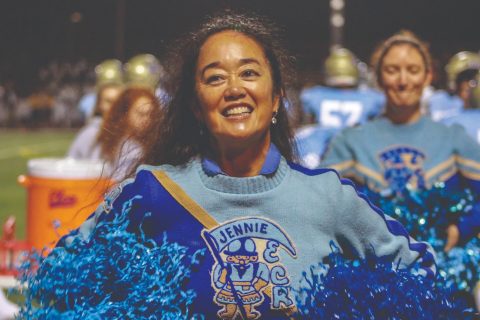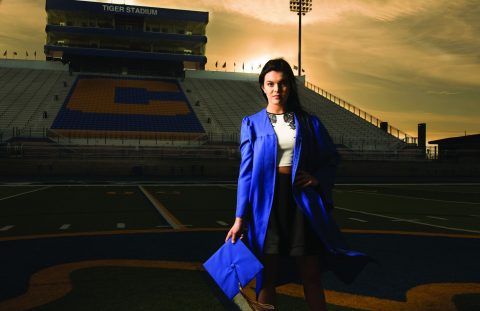Every year, the process of creating the yearbook for the next year begins. So much time and effort go into the planning, organizing, collaborating, writing, shooting, designing – the creation – that it’s valuable to step back and discuss just whose book is it you are creating. How you view your audience and the ownership of the book greatly affects the content, the design and the direction it takes.
Will what goes into the book be determined primarily by those who create and do the work of putting it together or by the audience for which it is intended? To answer, the book belongs your audience, BUT … give them what they need, not just what they think they want. First let’s discuss who your audience should be.
TO which AUDIENCE DOES THE YEARBOOK BELONG?
It is the COMMUNITY’s book
Your school community will always be the primary audience for the book. Your goal should always be to provide a product with content and design so meaningful and relevant that everyone feels they MUST HAVE IT. But your book belongs to your local community too. Even future students and community members are a part of your audience. The yearbook is the permanent record of what happens at the school. As storytellers and historians, the yearbook staff has the responsibility to record as much of the history of the school as accurately as they can within the constraints of the size and budget of their book. What we put in the book must be detailed, objective and accurate.
It is the PARENTS’ Book
If they are purchasing senior tribute space and because they are members of both the local and school communities, it’s partly the parents’ book too. Parents are likely also providing the students with the money to pay for it. They have some level of ownership.
I had one parent who would read every word my students wrote. Her commentary was always positive and showed she cared about what we had to say about that specific year. Other parents may complain. Some complaints may be valid, so listen respectfully if you did miss an opportunity to include a club that was overlooked, but take it with a grain of salt if unreasonable complaints arise. Parents don’t know all the work involved. It may be a great opportunity to invite their child to join the staff next year to eliminate the future concern.
TO which AUDIENCE DOES IT NOT BELONG?

It is NOT the NATIONAL JOURNALISM COMMUNITY’s book
You may plan to submit your book to judges in hopes of getting useful feedback and perhaps national recognition, but it’s dangerous to allow them to guide your vision. Too often, we are guided more by what the judges might say than by the best way to tell the story of the year at your school. It may be important to you to try to get national recognition, but do not let it be the guiding force in your decision-making process
It is NOT the SENIOR CLASS’ book
The book should belong to everyone on campus. Some schools create senior-only yearbooks, but I feel it is a more accurate representation of the school community to include all grades. Many seniors have friends, teammates, club members, siblings and classmates in a different grade. To fully represent the senior class experience, the entire school should be covered.
An added benefit of a more inclusive yearbook is improved buy rates, providing a bigger budget to add extras to the book or attend workshops and conventions so seniors on staff have the best yearbook experience that prepares them for the next chapter of their lives. Expand your sales and your audience by targeting ALL classes.
It is NOT the ADMINISTRATION’s book
Your administration can be your biggest ally in creating your book. However, the book belongs to them only to the degree that they are an active part in the local and school communities as well.
Many schools decide to discuss specific content with the administration. That is a decision you should make based upon your relationship and the needs of your campus. Having a principal who fully supports you, your students and student press rights makes for a powerful advocate who can help if you are faced with displeased parents.
The Student Press Law Center (SPLC.org) offers great support and advice on working with your administration and understanding your rights and responsibilities as student journalists. They can also explain how student press freedom laws apply in your state.
THE BOOK BELONGS TO THE CREATORS
The book also really belongs to those who are sacrificing their time and energy to create the best book possible. Taking into careful consideration the various components of their audience, it is ultimately the responsibility of the book creators to make the decisions necessary to produce the best possible book. So, to which creators DOES the yearbook belong?
It is the EDITORIAL STAFF’s book
The editors are the most important part of the equation. As student leaders, they are responsible for all decisions regarding the style and content of the book. Whatever the book becomes, it will be through their vision, leadership, guidance and coaching. It will be the editors who make sure all work gets done at the quality level they have determined. The book is theirs because the work just won’t get done without their commitment and drive.
At the beginning of the year I would always have the same discussion with my editors. “Just what kind of a book do you want to produce?” and “Are you prepared to do what is necessary to make that kind of a book a reality?” Do you want it to be up to the standard all the staffs before you have set? Do you want to follow in the footsteps of all that editors who came before you regarding quality and effort? Do you care about being recognized by others beyond our school community? Do you want to do the best book the school has ever seen? Do you want to do a good, solid book in the time you have available?
It was their choice even though they could never really have a full understanding of what lay ahead.

It is the YEARBOOK STAFF’s book
These are the people who take on the challenge of doing all the reporting, writing, shooting and designing to make the book a reality. The book is theirs because nothing would appear between the boards of the cover without them. The staff conducts every interview, writes every story, takes every photo and creates every design, no matter what the size of the book. It is easy for the editors to take them for granted at times, but the staff is the heart and soul of the book, and it belongs to them too.
It is NOT the ADVISER’s book
The adviser is there first to teach and then to guide and advise the student leaders and staff every step of the way in the book creation process. Like the captain of a ship, the adviser has their hand on the tiller guiding the direction the ship will travel, but the staff and editors are always keeping the ship moving forward.
The adviser does hold the most crucial role in the process. Because the students are new to the process of creating a book, first they must be TAUGHT what are the foundations of great journalism – reporting, photography and design. They must be guided in becoming great leaders. With the experience of a great adviser, the staff and editors can be shown what options they have and the most effective path to execute them. Then once the teaching has been done, the role of the adviser is to coach and guide the editors and staff as the process continues. I have seen advisers take too much ownership of the book and begin to DO THE WORK that the students should be doing. An adviser should take no photos, create no designs, write no stories.
So, Whose Book Is It? It belongs to whoever the staff and editors identify as their audience, and they must take on the responsibility of creating their best possible book with ALL of them in mind. Once it has been created though, the book, as one friend put it, “Belongs to the Ages.”





